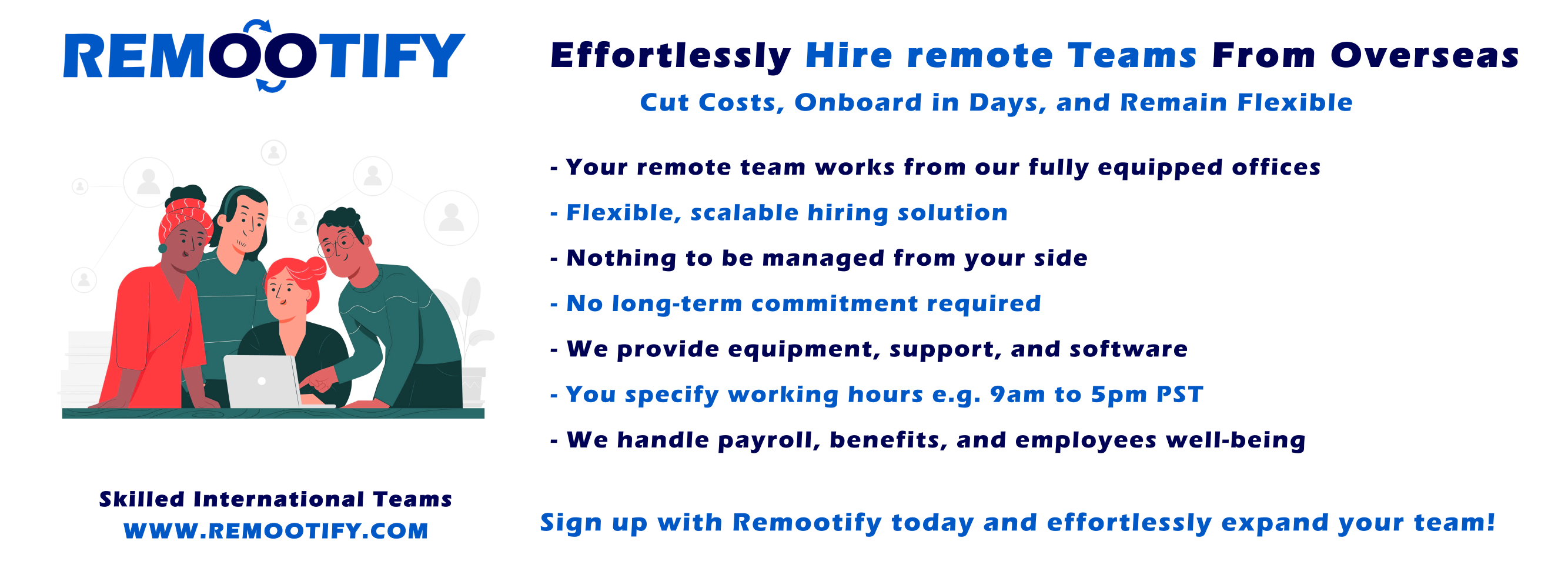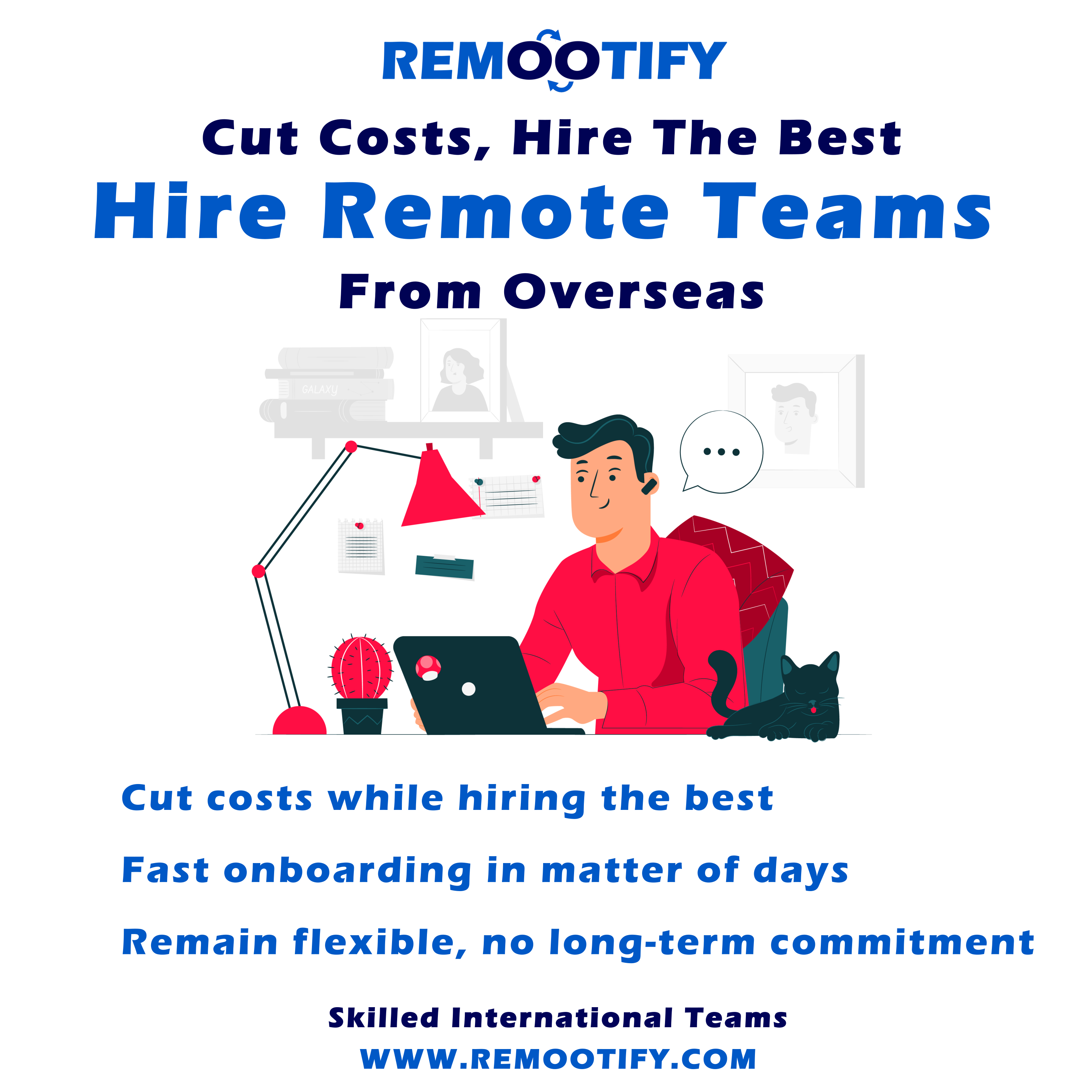Start hiring YOUR REMOTE TEAM, Today!
Enter your information below to start a discussion with one of our team members!

In the realm of remote work, people analytics has gained paramount importance.
As traditional work structures evolve, harnessing data-driven insights becomes crucial.
People analytics enables organizations to decipher trends in employee performance, engagement, and well-being, fostering informed decision-making in the virtual workspace.
This approach not only ensures productivity but also nurtures a thriving remote work environment.
Today’s article delves into the significance of people analytics in remote work, outlining its evolution, key aspects, and how it optimizes the virtual work landscape.
Understanding People Analytics
Definition of people analytics
| People Analytics | A data-driven approach to understanding and improving workforce performance |
| Purpose | Analyzing employee data and patterns for informed decision-making |
| Focus | Employee engagement, productivity, and well-being |
| Application | Enhancing workplace strategies and organizational success |
| Role in Remote Work | Vital for managing and optimizing remote workforce dynamics |
Understanding the Essential Aspects of People Analytics
Evolution of people analytics in HR
Early Stage
- Limited technology adoption.
- Manual record-keeping and basic data collection.
- HR primarily focused on administrative tasks.
- Basic reporting on headcount, payroll, and basic employee information.
Emergence of HRIS (Human Resources Information Systems)
- The advent of computer systems for data storage.
- Automating processes like payroll, and benefits administration.
- Initial data-driven insights, but mostly transactional.
Basic Metrics and Reporting
- Introduction of key HR metrics (e.g., turnover rate, time-to-fill).
- Basic reporting using spreadsheets and simple analytics tools.
- Limited predictive analysis for workforce planning.
Integrated HR Analytics Platforms
- Rise of integrated HR analytics software.
- Combining data from various sources (HRIS, surveys, performance data).
- Basic descriptive analytics to understand trends and patterns.
Focus on Employee Experience
- Shift towards understanding employee needs and engagement.
- Pulse surveys, sentiment analysis, and feedback data.
- Analyzing employee lifecycle to enhance retention and satisfaction.
Advanced Analytics and Predictive Modeling
- Utilizing machine learning for predictive modeling.
- Forecasting turnover, identifying flight risks, and skills gaps.
- In-depth analysis of recruitment channels’ effectiveness.
Strategic Workforce Planning
- Aligning HR data with organizational goals.
- Scenario planning using workforce analytics.
- Identifying future talent needs and skill requirements.
Diversity and Inclusion Analytics
- Using data to drive diversity and inclusion initiatives.
- Measuring representation, pay equity, and inclusion metrics.
- Adjusting strategies based on analytical insights.
AI and Natural Language Processing
- Leveraging AI and NLP for text analysis (e.g., performance reviews).
- Gaining deeper insights from unstructured data.
- Personalized recommendations for employee development.
Real-time and Prescriptive Analytics
- Real-time tracking of HR metrics and workforce trends.
- Prescriptive analytics suggests interventions for better outcomes.
- Continuous monitoring of employee sentiment and engagement.
Ethical and Privacy Considerations
- Focus on data privacy and ethical data usage.
- Ensuring compliance with regulations (e.g., GDPR).
- Balancing analytics with employee privacy rights.
Holistic People Strategy
- Integration of people analytics into overall business strategy.
- Data-driven decision-making at all HR levels.
- Agile adaptation based on evolving analytics insights.
Predictive and Organizational Network Analysis
- Predicting team performance through network analysis.
- Identifying influential employees and collaboration patterns.
- Enhancing team dynamics and innovation.
Continuous Learning and Evolution
- Ongoing learning from data and refining analytics approaches.
- Embracing emerging technologies and methods.
- Adapting to changing workforce dynamics and business needs.
The Role of data and technology in people analytics
Data Gathering: Data and technology enable the collection of vast amounts of employee-related information.
Insights Generation: Advanced analytics tools process data to extract valuable insights about workforce trends and behavior.
Decision Making: Data-driven insights aid in making informed HR decisions, from recruitment to performance management.
Predictive Analysis: Technology allows for predicting future workforce trends and potential issues based on historical data.
Personalization: Tailored employee experiences can be created by analyzing individual preferences and needs.
Performance Evaluation: Data helps in assessing employee performance objectively, leading to fair evaluations.
Talent Management: Technology assists in identifying and nurturing top talent within the organization.
Employee Engagement: Insights from data enhance engagement strategies, boosting overall morale and satisfaction.
Retention Strategies: Analyzing data helps in understanding factors influencing employee turnover and implementing retention plans.
Diversity and Inclusion: Data-driven approaches aid in promoting diversity and creating inclusive workplaces.
Enhancing Remote Work through People Analytics
- People analytics is instrumental in optimizing remote work scenarios.
- Data-driven insights from analytics aid in measuring and enhancing remote productivity.
- Collaboration patterns and communication effectiveness can be analyzed to improve remote teamwork.
- Employee engagement and well-being metrics offer insights into the remote work experience.
- Informed decisions based on analytics help address challenges and tailor strategies for remote work success.
The Vitality of People Analytics in Remote Work
Performance Measurement: People analytics enables objective measurement of remote employees’ performance, ensuring accountability and productivity are maintained.
Insightful Decision-Making: Data-driven insights guide informed decisions, leading to optimized remote work strategies and resource allocation.
Employee Well-being: Analytics help monitor remote workers’ well-being, identifying signs of burnout or disengagement and allowing timely interventions.
Tailored Support: By analyzing collaboration patterns and communication effectiveness, organizations can provide targeted support to enhance remote team dynamics.
Adaptation and Flexibility: People analytics aids in identifying trends and shifts in remote work patterns, enabling organizations to adapt swiftly to changing circumstances.
Optimized Communication: Insights from analytics facilitate the development of effective communication strategies tailored to remote work settings.
Continuous Improvement: Regular analysis of remote work data allows for ongoing improvement in processes, workflows, and the overall remote work experience.
Cultivating Engagement: Analytics help create initiatives that foster remote employee engagement, motivation, and a sense of belonging to the organization.
Strategic Planning: Leveraging analytics ensures a strategic approach to remote work, aligning organizational goals with the needs and realities of remote teams.
Key Steps for Effective People Analytics in Remote Work
Applying people analytics in remote work involves using data-driven insights to improve various aspects of remote work, such as productivity, engagement, well-being, and overall performance.
Here are steps to effectively apply people analytics in a remote work setting:
1. Define Clear Objectives
Determine what specific goals you want to achieve through people analytics in remote work.
Are you trying to increase productivity, enhance employee engagement, reduce turnover, or improve overall well-being?
Clear objectives will guide your data collection and analysis efforts.
2. Data Collection
Collect relevant data from remote employees. This can include quantitative data such as work hours, task completion rates, communication patterns, and qualitative data from surveys, feedback, and one-on-one conversations.
Ensure that data collection methods respect employees’ privacy and comply with data protection regulations.
3. Choose Key Metrics
Select key performance indicators (KPIs) that align with your objectives.
These could include metrics like average task completion time, number of meetings attended, collaboration rates, response time to messages, and self-reported job satisfaction.
4. Use Technology Tools
Leverage technology tools to gather and analyze data efficiently.
Employee monitoring software, project management tools, communication platforms, and survey tools can provide valuable insights into remote work dynamics.
5. Analyze Data
Interpret the collected data to identify patterns, trends, and correlations.
Look for insights related to productivity, engagement, communication frequency, and any challenges remote employees might be facing.
6. Identify Opportunities and Challenges
Based on your analysis, identify areas of strength and areas that need improvement in the remote work environment.
Are there bottlenecks in communication? Is there a drop in productivity during certain times of the day? Are employees feeling isolated?
Pinpoint specific opportunities and challenges.
7. Implement Interventions
Develop strategies and interventions to address the identified challenges and capitalize on opportunities.
For instance, if communication seems lacking, implement practices that encourage regular virtual check-ins and team meetings.
If work-life balance is an issue, promote flexible scheduling.
8. Monitor Progress
Continuously monitor the impact of your interventions. Are the changes leading to positive outcomes? Are you achieving the desired improvements in engagement, productivity, or other metrics?
Adjust your strategies based on the feedback and outcomes.
9. Feedback and Communication
Maintain open channels of communication with remote employees. Seek their feedback on the implemented changes.
Regularly share insights and progress updates derived from people analytics.
This can enhance transparency and trust within the remote team.
10. Iterate and Refine
Remote work dynamics can evolve over time. Regularly review and refine your people analytics approach to stay aligned with the changing needs and challenges of remote employees.
11. Ethical Considerations
Be mindful of ethical considerations and employee privacy when collecting and analyzing data. Ensure that your data usage complies with legal and regulatory standards.
12. Training and Support
Provide training and support to both managers and employees in using people analytics effectively.
Managers should be trained in interpreting data, making informed decisions, and implementing changes that positively impact remote work.
People Analytics Through Remote Work Service Providers
Data Collection and Tracking
- Gather data on remote employee activities, including task completion times, communication patterns, and work outcomes.
- Provide a comprehensive overview of individual and team performance through data-driven insights.
Performance Metrics
- Define relevant KPIs for remote workers to measure productivity, efficiency, and other performance aspects.
- Enable organizations to assess employee contributions and set performance goals based on quantifiable metrics.
Collaboration Tools
- Offer specialized tools that enhance remote team collaboration, generating data on interaction frequency and project cooperation.
- Provide a platform for analyzing team dynamics and identifying areas for improving remote teamwork.
Engagement and Satisfaction Surveys
- Conduct regular surveys to evaluate remote employees’ job satisfaction, engagement levels, and well-being.
- Collect feedback to pinpoint areas needing enhancement and create a more positive remote work experience.
Behavioral Analysis
- Analyze remote workers’ behavior patterns, such as response times and work hours, to gain insights into time management and potential burnout risks.
- Offer data-driven suggestions for optimizing work habits and balancing workload effectively.
Predictive Analytics
- Utilize historical data to forecast potential challenges, such as periods of decreased productivity or high turnover rates.
- Help organizations proactively address issues and make informed decisions to maintain remote work efficiency.
Feedback Mechanisms
- Establish efficient feedback channels between remote employees and managers, promoting open communication and personalized development.
- Enable managers to provide targeted coaching and support based on performance insights.
Customized Training and Development
- Identify skill gaps and training needs among remote workers through performance data analysis.
- Offer tailored training programs to enhance remote employees’ skills and address specific development areas.
Work-Life Balance Monitoring
- Analyze work hours, response times beyond regular hours, and usage of time management tools to assess work-life balance.
- Provide recommendations for maintaining a healthier work-life integration among remote team members.
Diversity and Inclusion Insights
- Analyze collaboration and communication patterns to offer insights into diversity and inclusion efforts within remote teams.
- Identify potential disparities in participation and decision-making among remote team members, aiding in addressing inclusion challenges.
Compliance and Security
- Monitor remote employees’ adherence to company policies and security protocols, ensuring data protection compliance.
- Help maintain secure remote work environments by providing insights into potential security vulnerabilities.
Benchmarking and Industry Insights
- Offer benchmarking data and industry trends to allow organizations to compare their remote work practices with peers.
- Provide insights that enable organizations to align their remote work strategies with industry standards and best practices.
Continuous Improvement
- Continuously analyze remote work data to assist organizations in refining remote work strategies.
- Support organizations in adapting to evolving circumstances and consistently enhancing their remote work practices.
—
Conclusion
In remote work, People Analytics is vital. It deciphers employee trends, informs decisions, and boosts virtual workspace success.
It measures productivity, guides interventions, and ensures ethical data use.
Partnering with service providers offers specialized tools for collaboration and compliance, enhancing remote work strategies.
—
FAQs
Why is people analytics important in remote work?
People analytics helps measure remote productivity, teamwork, and well-being, enabling informed decisions for a successful virtual work environment.
How does people analytics impact remote employee performance?
It objectively measures remote performance, ensuring accountability and providing insights for productivity enhancements.
How can organizations apply people analytics effectively in remote work?
Clear objectives, data collection, analysis, identifying opportunities/challenges, implementing interventions, and continuous refinement are key steps.
What benefits do remote work service providers offer with people analytics?
Service providers offer specialized tools for data collection, performance metrics, collaboration enhancement, and compliance monitoring in remote work scenarios.





